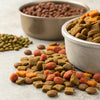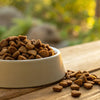Can I Feed My Dog Wet and Dry Food? Exploring the Benefits of Mixing Meals
- Houndsy
Table of Contents
- Introduction
- Understanding Wet and Dry Dog Food
- The Benefits of Mixing Wet and Dry Dog Food
- Considerations When Mixing Wet and Dry Dog Food
- How to Effectively Mix Wet and Dry Dog Food
- Conclusion
Introduction
Did you know that nearly 70% of dog owners mix wet and dry food for their pets? It’s a common practice that sparks plenty of questions, especially among pet parents wondering if this combination is beneficial or even safe. As dog lovers ourselves, we understand the importance of providing our furry friends with the best nutrition possible while also making mealtime enjoyable.
In this blog post, we’ll delve into the intricacies of mixing wet and dry dog food, exploring the benefits, potential drawbacks, and practical tips for those considering this approach. By the end, you’ll have a better understanding of how this feeding strategy can enhance your dog’s overall well-being and satisfy their taste buds.
We’ll cover topics such as the nutritional differences between wet and dry foods, the specific advantages of mixing them, and how to do it effectively. We’ll also reflect on our commitment at Houndsy to elevate the daily feeding ritual with innovative solutions like our Houndsy Kibble Dispenser, which perfectly complements any dog feeding routine.
So, let’s wag our tails and dive into the world of dog nutrition!
Understanding Wet and Dry Dog Food
What is Dry Dog Food?
Dry dog food, commonly referred to as kibble, is a staple in many households. It is designed to provide balanced nutrition and is often more cost-effective than its wet counterparts. Here are some key characteristics of dry dog food:
- Moisture Content: Dry food typically contains less than 12% moisture, making it shelf-stable and easy to store.
- Oral Health Benefits: The crunchy texture of kibble can help clean a dog’s teeth as they chew, reducing plaque buildup.
- Cost-Effectiveness: Generally, dry food is more affordable, allowing pet owners to feed their dogs without breaking the bank.
- Convenience: Kibble is easy to measure and doesn’t require refrigeration once opened, making it a hassle-free choice for many pet parents.
What is Wet Dog Food?
Wet dog food, often found in cans or pouches, is favored for its palatability and moisture content. Here’s what you should know:
- Moisture Content: Wet food contains approximately 75–80% moisture, which can help keep dogs hydrated.
- Appealing Aroma: The scent and texture of wet food are often more enticing for dogs, making it an excellent option for picky eaters.
- Easier to Chew: Wet food is softer and easier to consume, particularly for puppies, senior dogs, or those with dental issues.
- Limited Shelf Life: Once opened, wet food must be refrigerated and consumed within a few days to prevent spoilage.
The Benefits of Mixing Wet and Dry Dog Food
Mixing wet and dry dog food can offer numerous advantages, both nutritionally and practically. Here are some compelling reasons to consider this feeding strategy:
1. Enhanced Taste and Variety
Just like us, dogs can get bored with the same meal every day. By mixing wet and dry food, we introduce new flavors and textures that can make mealtime exciting again. This variety can be particularly beneficial for dogs that are picky eaters or those that may have lost interest in their regular kibble.
2. Improved Hydration
Adding wet food to a dog’s diet can significantly increase their overall water intake. This is especially important for dogs prone to urinary or kidney issues, as increased hydration can help support their health. If your dog tends to drink less water, mixing in wet food could be a game changer for their hydration levels.
3. Nutritional Balance
Both wet and dry foods have unique nutritional benefits. By combining them, we can create a more balanced meal that leverages the advantages of each. For example, the high protein content found in many wet foods can complement the fiber and carbohydrate sources in dry kibble.
4. Increased Satiety
Wet food can help dogs feel fuller faster due to its high moisture content. This can be particularly helpful for dogs that are overweight or those needing to lose a few pounds. Conversely, for underweight dogs, mixing in dry kibble can help boost calorie intake without compromising palatability.
5. Dental Health Maintenance
While wet food is softer and easier to chew, dry food offers dental benefits. Mixing both can strike a balance, allowing dogs to enjoy the crunchiness of kibble while still getting the hydration benefits of wet food.
Considerations When Mixing Wet and Dry Dog Food
While there are many benefits to mixing wet and dry food, it’s essential to approach this strategy with care. Here are some considerations to keep in mind:
1. Nutritional Balance
Ensure that the combination of wet and dry food meets your dog’s nutritional needs. Consult with your veterinarian to determine the right ratios based on your dog’s size, age, and activity level. Generally, a mix of 75% dry food to 25% wet food is recommended, but this can vary based on individual needs.
2. Monitor Weight
When changing your dog’s diet, it’s crucial to monitor their weight. Mixing wet and dry food can lead to unintentional overfeeding if not managed correctly. Keep track of their daily calorie intake, including treats, to avoid unwanted weight gain.
3. Allergies and Sensitivities
If your dog has food sensitivities or allergies, be cautious when introducing new foods. Stick to brands that offer high-quality, hypoallergenic options to minimize the risk of adverse reactions.
4. Storage Considerations
Keep in mind that wet food requires refrigeration once opened. Ensure you are storing it properly to maintain freshness and avoid spoilage. Conversely, dry food should be kept in a cool, dry place to preserve its quality.
How to Effectively Mix Wet and Dry Dog Food
Now that we understand the benefits and considerations, let’s explore some practical tips for mixing wet and dry dog food effectively:
1. Start Gradually
When introducing a new food or mix to your dog’s diet, do so gradually. Start by adding a small amount of wet food to their regular dry kibble to see how they respond. If they enjoy it, you can slowly increase the proportion of wet food over time.
2. Use High-Quality Products
Choose high-quality wet and dry dog foods that meet AAFCO (Association of American Feed Control Officials) standards. Look for products that list meat as the first ingredient and avoid those with fillers or artificial additives.
3. Keep It Fresh
Always check expiration dates on both wet and dry food. Once opened, wet food should be consumed within a few days, while dry food can last longer. Use airtight containers to store dry kibble to maintain its freshness.
4. Monitor Your Dog’s Health
As you mix wet and dry food, keep an eye on your dog’s overall health. Monitor their weight, energy levels, and digestive health. If you notice any changes, consult your veterinarian for guidance.
5. Make Mealtime Fun
Consider using interactive feeding tools, like puzzles or slow feeders, to make mealtime more engaging. Our Houndsy Kibble Dispenser enhances the feeding experience by allowing you to dispense the perfect portion at the perfect height, reducing the need for bending and creating a cleaner feeding area.
Conclusion
In conclusion, mixing wet and dry dog food can provide a multitude of benefits, from enhanced taste and hydration to improved nutritional balance. By carefully considering your dog’s individual needs and following best practices for mixing, we can create a feeding routine that keeps our furry friends happy and healthy.
At Houndsy, we believe in elevating the dog-feeding experience through innovative design and functionality. Our flagship product, the Houndsy Kibble Dispenser, is designed to simplify the feeding ritual while delivering perfect portions every time. By investing in quality feeding solutions, we can ensure our pets receive the nutrition they deserve while enjoying mealtime.
As you consider incorporating both wet and dry food into your dog’s diet, we invite you to explore our Houndsy Kibble Dispenser and see how it can elevate your pet’s feeding experience. Order Now and discover the convenience and style it brings to your home!
FAQ
Can I mix wet and dry dog food?
Yes, mixing wet and dry dog food is generally safe and can offer various benefits, including improved hydration and enhanced palatability.
What is the best ratio for mixing wet and dry food?
A common recommendation is to use 75% dry food and 25% wet food, but this can vary based on your dog's individual needs. Consult your veterinarian for personalized advice.
Are there any downsides to mixing wet and dry food?
Potential downsides include possible weight gain if portions are not managed correctly and the need to monitor your dog for any allergies or sensitivities.
How should I store opened wet dog food?
Once opened, wet dog food should be refrigerated and consumed within a few days. Always check the expiration date before use.
What are the benefits of using the Houndsy Kibble Dispenser?
The Houndsy Kibble Dispenser offers ergonomic convenience by dispensing perfect portions at standing height, reducing messiness and enhancing the overall feeding experience. Discover the Houndsy Kibble Dispenser!












